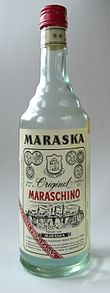Maraschino
Maraschino [ marasˈkiːno ] is a cherry liqueur made from maraska cherries , an originally Dalmatian , intensely tasting sour cherry variety . It is clear and colorless, has an alcohol content of around 30% vol and a spicy cherry aroma with a clearly perceptible bitter almond note . The liqueur is not made with the addition of fruit juice, but gets its cherry aroma from the distillate of fermented or cold-drawn Marasca cherries. The bitter almond taste is said to be due to the use of chopped cherry stones.
According to the European spirits regulation, Maraschino has a minimum alcohol content of 24% vol and a minimum sugar content of 250 g / l. Only natural flavoring substances and extracts may be used; nature-identical flavors are not permitted.
Maraschino was developed and commercialized into an industrial product in the 18th century in Zadar (in today's Croatia ), at that time a Venetian fortress with the Italian name Zara . Originally, the recipe is said to come from the local Dominican monastery. Today there are manufacturers in Zadar and Padua , but also outside the traditional Adriatic region of origin. A typical design feature of the bottles is a cover made of bast fiber mesh .
Manufacturing
The starting product for Maraschino is a distillate of Marasca cherries, which can be obtained in two ways: Either by distilling fermented maraskets or by distilling an alcoholic extract from these cherries, which are mashed in agricultural alcohol , allegedly also using other parts of the plant. Spices such as rose oil , cinnamon or vanilla can also be added to round off the taste . The distillate produced in this way is high-percentage (60–70% vol) and very economical. To make the maraschino liqueur, it is diluted in a ratio of 1:10 to 1:25 and then sugared accordingly.
history
The first distillery for maraschino liqueur was founded in Zadar in 1736. The first imitator was the merchant Girolamo Luxardo , others like Vlahov followed. In 1829 Luxardo was granted the privilege to produce the liqueur on its own. After the Second World War, when Zadar was annexed to Yugoslavia , the manufacturers emigrated to Italy in Veneto. The Luxardo family founded a new distillery in Torreglia near Padua, and they had meanwhile become the market leader. Today it sells its liqueur under the name Luxardo Maraschino , while the Croatian distillery in Zadar advertises its original maraschino from Zadar with the original and uninterrupted tradition.
use
Maraschino is part of numerous classic cocktails such as the Aviation , the Last Word and the Prince of Wales . In addition, maraschino is often used in the preparation of desserts or to refine the flavor of ice cream or fruit salad . Maraschino, on the other hand, is rarely drunk straight.
See also
Individual evidence
- ↑ a b Gundolf Ströhmer: Liqueurs . In: Erich Kolb (Ed.): Spirituosen-Technologie . 6th edition. Behr, Hamburg 2002, ISBN 3-86022-997-4 , pp. 356 .
- ↑ a b Illa Andreae: All schnapps in the world. The international book of liquid pleasures . Seewald, Stuttgart 1973, ISBN 3-512-00240-4 , pp. 164 .
- ↑ Regulation (EC) No. 110/2008 , Annex II No. 39 in conjunction with No. 32 c)
- ↑ Veronika Wengert: Baedeker Travel Guide Croatian Adriatic Coast Baedeker, 2014, p. 286

